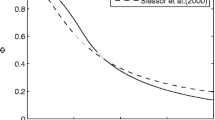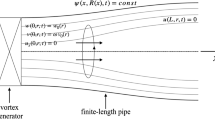Abstract
The Reynolds stress transport equation model (DSM) is used to predict the strongly swirling turbulent flows in a liquid-liquid hydrocyclone, and the predictions are compared with LDV measurements. Predictions properly give the flow behavior observed in experiments, such as the Rankinevortex structure and double peaks near the inlet region in tangential velocity profile, the downward flow near the wall and upward flow near the core in axial velocity profiles. In the inlet or upstream region of the hydrocyclone, the reverse flow near the axis is well predicted, but in the region with smaller cone angle and cylindrical section, there are some discrepancies between the model predictions and the LDV measurements. Predictions show that the pressure is small in the near-axis region and increases to the maximum near the wall. Both predictions and measurements indicate that the turbulence in hydrocyclones is inhomogeneous and anisotropic.
Similar content being viewed by others
References
Pericleous, K. A., Mathematical simulation of hydrocyclones, Appl. Math. Modelling, 1987, 11: 242.
Hsieh, K. T., Rajamani, R. K., Mathematical model of the hydrocyclone based on physics of fluid flow, AIChE Journal 1991, 37(5): 735.
Malhotra, A., Branion, R. M. R., Hauptmann, E. G., Modelling the flow in a hydrocyclone, Can. J. Chem. Eng., 1994, 72: 953.
Boyson, F., Ayers, W. H., Swithenbank, J., A fundamental mathematical modelling approach to cyclone design, Trans IChemE, 1982, 60: 222.
Hargreaves, J. H., Silvester, R. S., Computational fluid dynamics applied to the analysis of deoiling hydrocyclone performance, Trans JChemE, 1990, 68 (Part A): 365.
Hoffmann, A. C., Groot, M. De, Hospers, A., The effect of the, dust collection system on the flowpattern and separation efficiency of a gas cyclone, Can. J. Chem. Eng., 1996, 74: 464.
Zhou, L. X., Theory and Modeling of Turbulent Gas-particle Flows and Combustion, Beijing: Science Press and Florida: CRC Press, 1993.
Lu Yaojun, Experimental and numerical study on the strongly swirling turbulent two-phase flow and separation in liquid-liquid hydrocyclones, Ph. D. Thesis, Engineering Mechanics Department of Tsinghua University, Beijing, China (1997).
Patankar, S. V., Numerical Heat Transfer and Fluid Flow, New York: McGraw-Hill, 1980.
Lu Yaojun, Shen Xiong, Zhou Lixing, LDV diagnosis of the flow field in liquid-liquid hydrocyclones with double cylinder and single cone, Acta Mechanica Sinica, 1997, 23(3): 395.
Wolbert, D. I., Ma, B. F., Aurelle, Y., Efficiency estimation of liquid-liquid hydrocyclones using trajectory analysis, AIChE Journal, 1995, 41(6): 1395.
Author information
Authors and Affiliations
Corresponding author
Rights and permissions
About this article
Cite this article
Lu, Y., Zhou, L. & Shen, X. Numerical simulation of strongly swirling turbulent flows in a liquid-liquid hydrocyclone using the Reynolds stress transport equation model. Sci. China Ser. E-Technol. Sci. 43, 86–96 (2000). https://doi.org/10.1007/BF02917141
Received:
Issue Date:
DOI: https://doi.org/10.1007/BF02917141




